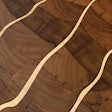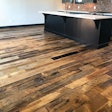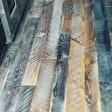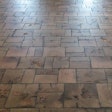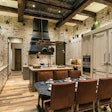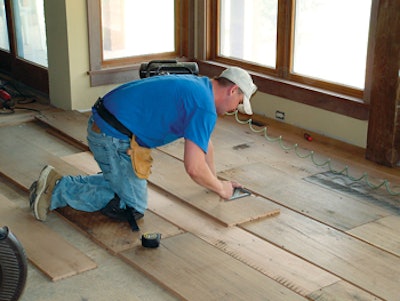
 Photo courtesy Olde Woods
Photo courtesy Olde Woods
Reclaimed wood flooring started as a niche product that served a small segment of the industry, but it has come a long way from those beginnings. Reclaimed products are now ubiquitous in today's market that demands flooring with an environmental story. As happens when a product surges in popularity, many suppliers have appeared to fill the need. But, of course, not all products are created equal, and misconceptions about the products abound. Here are some of the most common questions I am asked about reclaimed wood flooring and what you should expect as a professional when installing these products.
What are some things to be aware of when buying reclaimed flooring products?
It's important to buy from an experienced, reputable company when purchasing reclaimed materials. We've seen many reclaimed floors that had to be replaced due to problems related to improper milling, grading and kiln-drying. Just like any other wood floor product, reclaimed lumber should be kiln-dried to the industry standard of between 6 and 9 percent MC before being milled. This also kills any wood-boring insects that may be present in the lumber.
You need to be sure what you think you're buying is what you will get. When they say it's "reclaimed," what does that mean? Know the source of your material and whether it was originally harvested from an old-growth forest. We have seen floors sold as being reclaimed from barns and century-old structures that appear to actually be produced from recycled pallet lumber. Proper verbal and written descriptions, physical samples and photographs of the selected floors are all valuable tools in substantiating what the buyer can expect.
When you're looking at the actual product, what are some things to look for?
The milling is a good way to know if the company is making a good product. There are no uniform grading standards in the reclaimed market, but check that the boards fit together properly when laying on a flat surface. Ask the salesperson about the mill: What kind of equipment do they use? Do they kiln-dry their wood? If the flooring is being produced in a shed or someone's garage using elementary or outdated equipment, I would recommend looking for another product. Make sure they can provide proper documentation of the material processing, proper material packing for shipment and proper shipping.
It's helpful to know that there is an extremely high waste factor when producing a floor reclaimed from a 100-plus-year-old structure. Many times we've replaced flooring for people who have purchased flooring improperly processed, graded and milled. Much of the expense of a reclaimed floor lies in the high waste factor of the resource and the labor-intensive process of properly grading/preparing and milling the material. Learning how (and having the discipline) to grade and reject material is a skill learned only by years of experience.
RELATED: What I've Learned Working With Reclaimed Wood Flooring
Is reclaimed flooring installation more labor-intensive than other wood flooring products?
Contractors who think reclaimed products are more work have either had a bad experience with a shady manufacturer or are simply unfamiliar with the product. Quality manufacturers produce reclaimed flooring with the wood flooring's industry-wide standard waste factor of 5-7 percent. Often reclaimed wood flooring is characterized as too character-laden due to age and the effect of weather and time, but most people select the reclaimed option due to the beauty of those characteristics and accept that some additional attention needs to be given to the proper filling of any holes and voids that were left in the wood intentionally. There are steps and "trade secrets" to producing a quality reclaimed floor, and after those steps have been taken, the end product should install the same as your average strip flooring. The labor involved to sand and finish a reclaimed floor in most cases carries the same labor as any other floor. Keep in mind: If a company's reclaimed flooring product is unbelievably low in price, there is a reason ... which leads us to the next common question:
Is reclaimed always more expensive than other wood flooring products?
Reclaimed wood is actually competitively priced with many other custom-produced wood flooring options, whether specialty new wood flooring, imported options or flooring with an applied texture of some type. Since reclaimed wood flooring mainstreamed over the course of the past 15 years or so, many of these options are actually "spin offs" in appearance to the natural beauty of reclaimed wood products, and at prices comparable to, or higher than, the real thing.
How do installers handle character like open knots in a reclaimed floor?
On prefinished products, some manufacturers will fill open knots, nail holes and checking to make the product more user-friendly. For unfinished flooring, most installers have their own unique finishing methods, and filling some of the holes is common practice to enhance the overall appearance of the flooring and to maintain longer average lengths. Cutting these natural characteristics out would take away from the natural and authentic appearance of the reclaimed wood; in fact, customers who show initial concern about the holes, knots and other weathered features often mention that is what they love most about their floor after installation. Sanding and finishing of a reclaimed product can be as easy as any other floor, or it can be unique and artistic as the person installing it. In fact, some contractors choose not to sand reclaimed flooring at all, just buffing and finishing it to maintain as much of the unique character as possible.
More photos:
 Photos courtesy Olde Woods
Photos courtesy Olde Woods






















